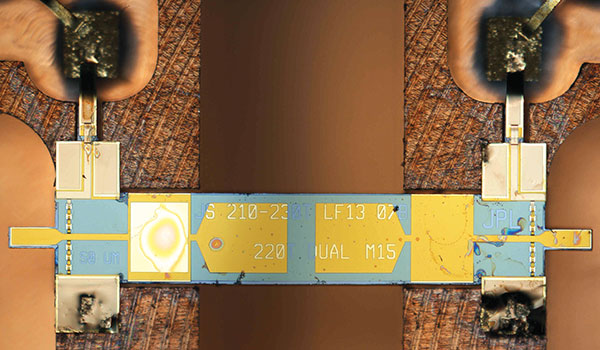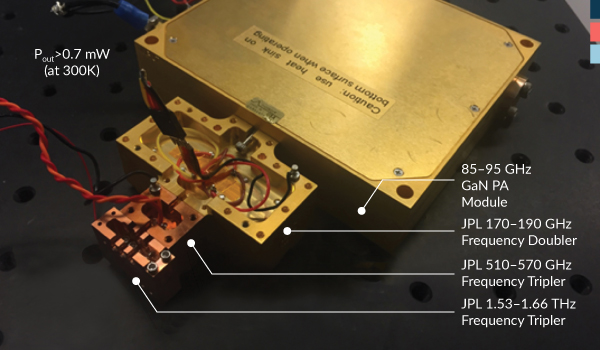Above:
Terahertz Device Advanced semiconductor fabrication technologies at MDL are utilized to fabricate THz devices that provide world-record output powers that enable future space submillimeter-wave spectrometers.
THz GAP
Closing the THz GAP
Jose Siles - Joseph (Choonsup) Lee - Robert Lin - Imran Mehdi
To make Terahertz devices even more useful, they need to be smaller, more efficient, versatile and tolerant of a wide range of operating conditions so that they can be deployed in an even greater range of NASA missions. MDL recently demonstrated room-temperature, all-solid-state local oscillator sources with output power levels more than 10 times higher than the previous state-of-the-art. These local oscillator sources are Schottky diode–based frequency multiplied chains featuring a novel JPL-patented circuit topology called on-chip power combining. This concept, together with a precise optimization of the devices for high-power operation yields an improvement in power-handling capabilities by one order of magnitude.
These results represent a major breakthrough in power generation at submillimeter-waves and terahertz frequencies and contribute enormously to close the so-called “terahertz gap”. Prototypes at 180, 230, 340, 530, and 1000 GHz have been designed, fabricated, assembled, and tested at JPL and record output power of 600, 120, 40, 30, 2.0, and 0.7 milliwatts have been measured, respectively.
The local oscillator sources operate at room temperature and exhibit state-of-the art conversion efficiencies and frequency bandwidths of around 15–20 percent. These Schottky based sources have important advantages over other technologies used such as quantum cascade lasers. For example, no cryogenic cooling is required and they have frequency tunability over a 15–20 percent bandwidth, thermal stability, Gaussian radiation patterns, and at least a 10 times reduction in size and power consumption. The new high-power JPL 1.6 THz local oscillator source is shown below. It has a power consumption of around 20 watts and produces and output power of > 0.7 milliwatts at 1.6 THz at room temperature. Further improvement can be achieved by cooling the source down to 120 K.
With these sources available, high-resolution THz imaging radar systems and high-data bit rate communication systems are now possible. For astrophysics, heterodyne array receivers beyond 1 THz are necessary to map galaxies in the search for nitrogen, oxygen, carbon, and other tracers of star-forming regions to fully understand how solar systems form and evolve.
A dual on-chip power-combined gallium arsenide 527 GHz tripler design is combined with a compact housing able to handle more than 500 milliwatts and produce a world-record output power of 30 milliwatts.
+ Larger image
Local Oscillator Source High-power 1.6 THz frequency multiplied local oscillator source recently demonstrated at JPL, exhibiting a world record output power of 0.7 milliwatts at room-temperature operation, which is a 10 times improvement over the previous state-of-the-art.
+ Larger image

